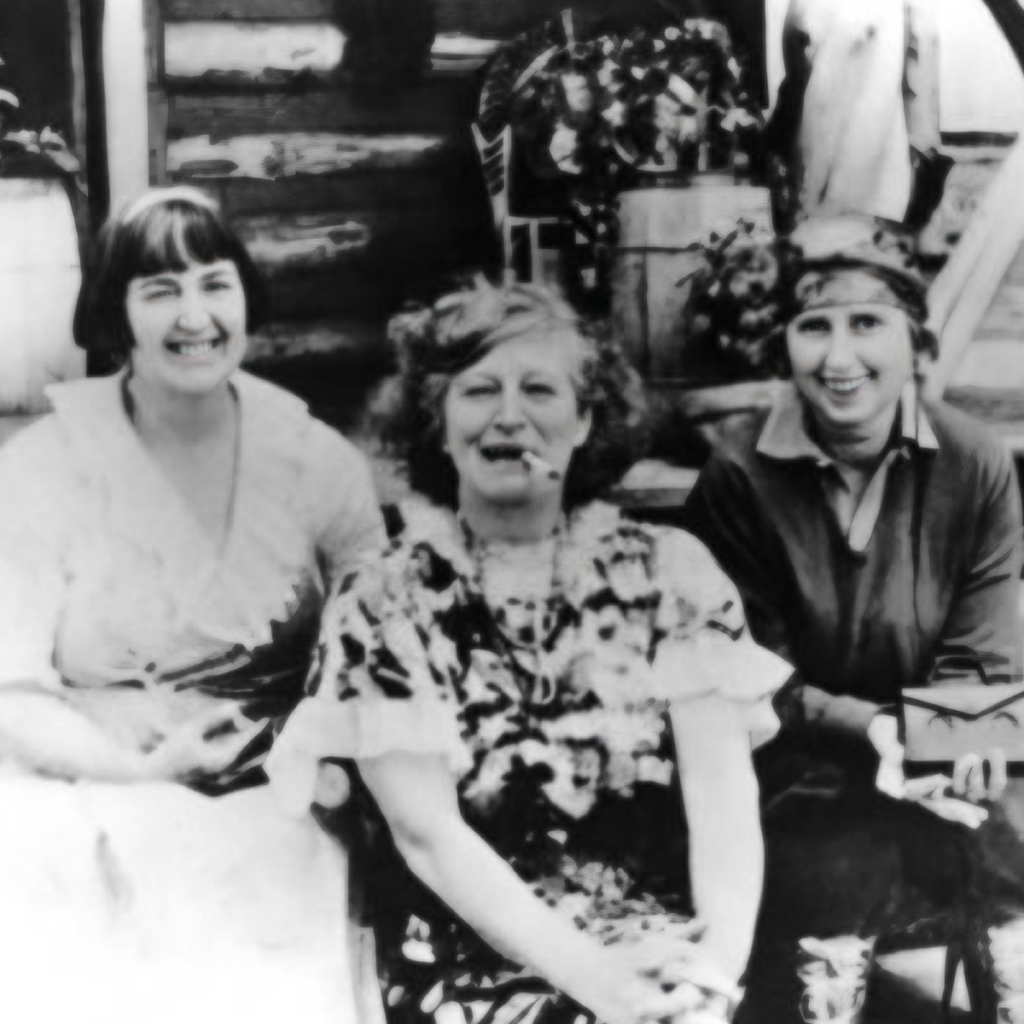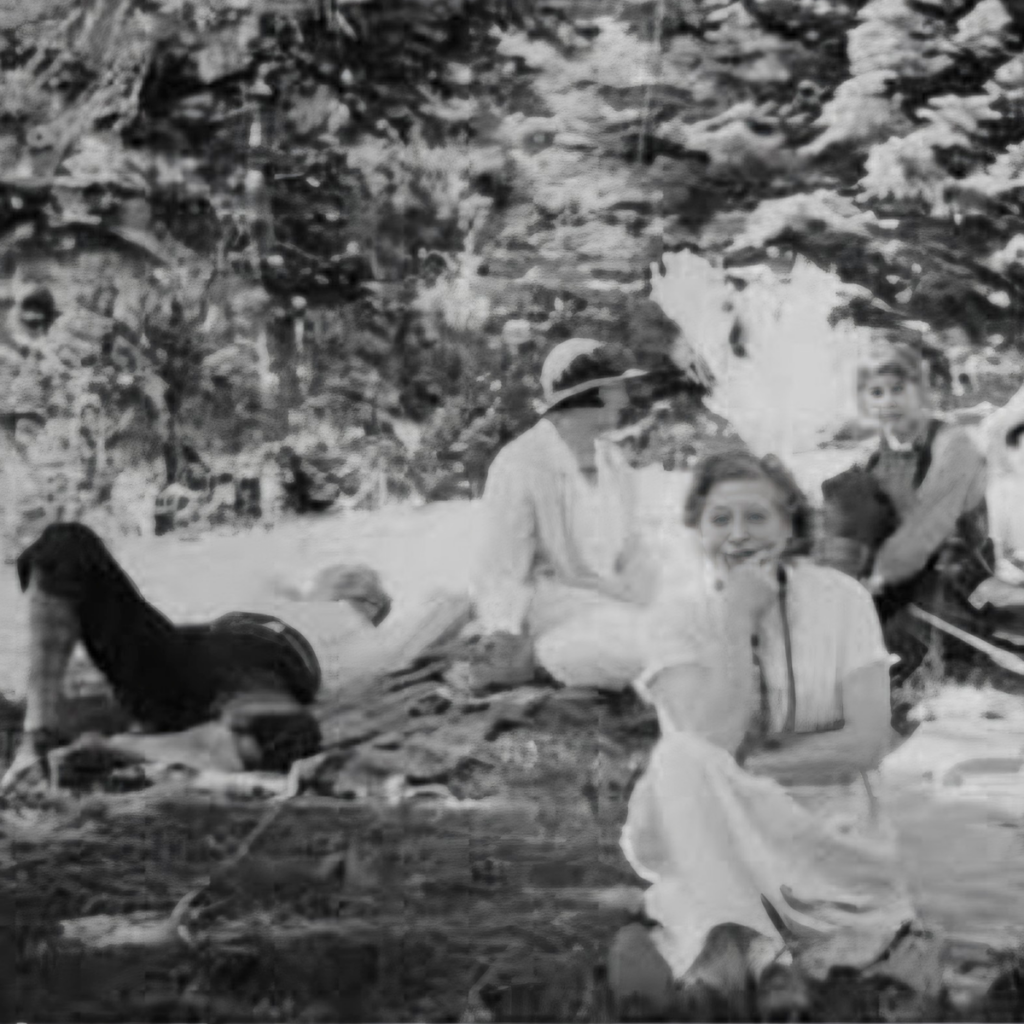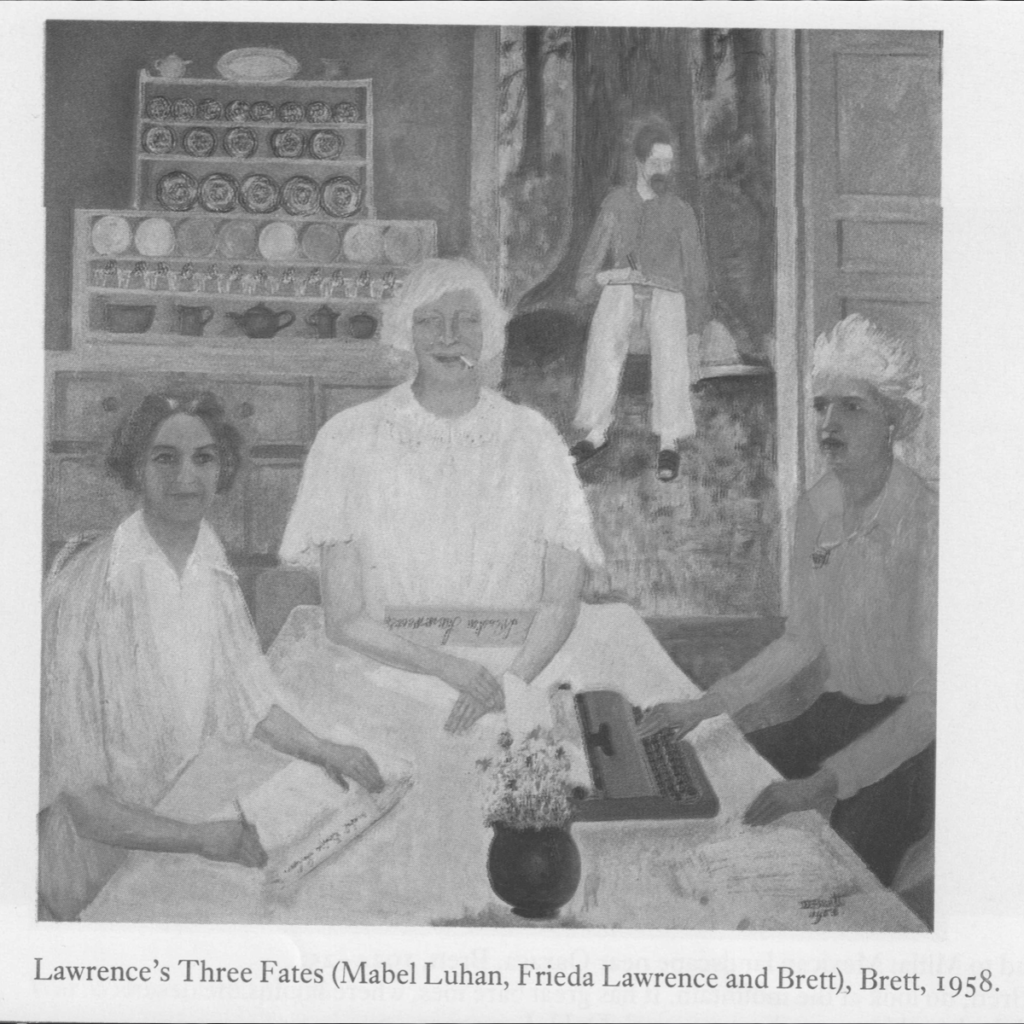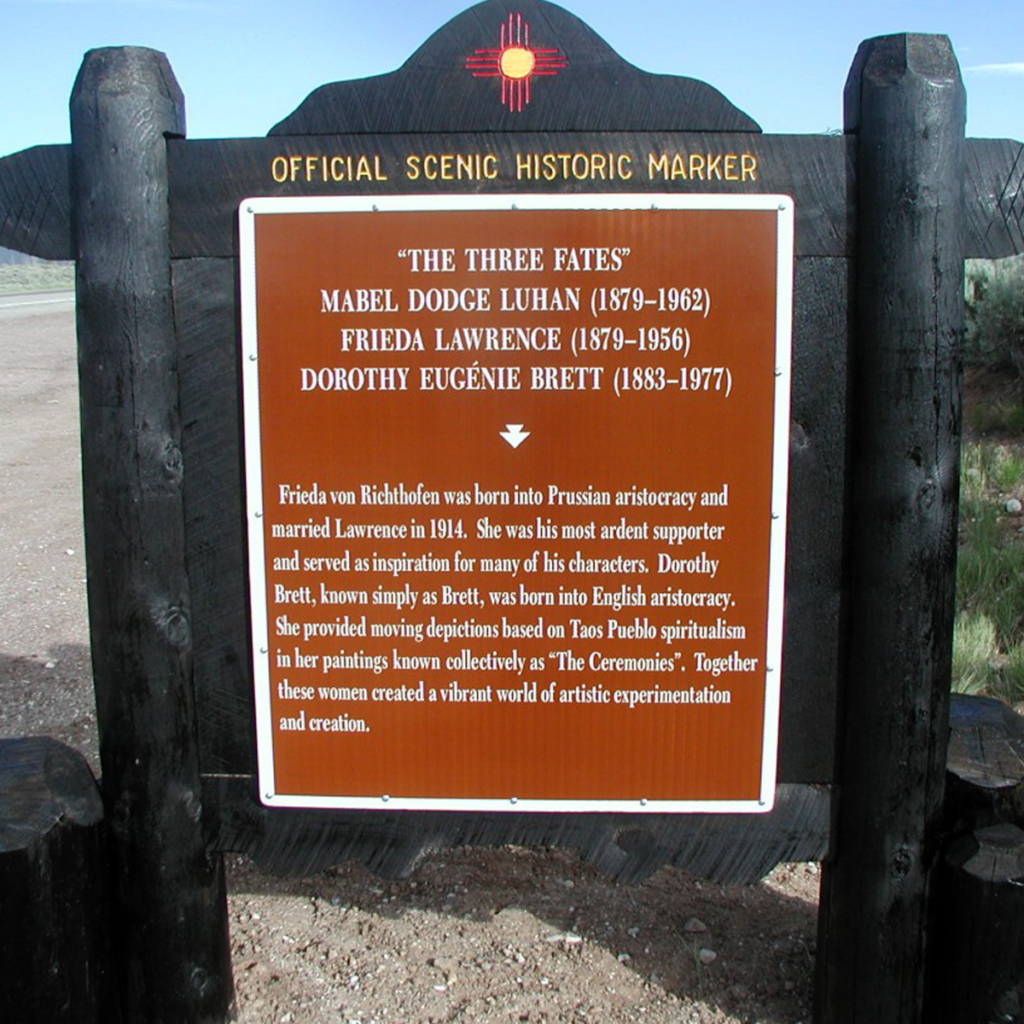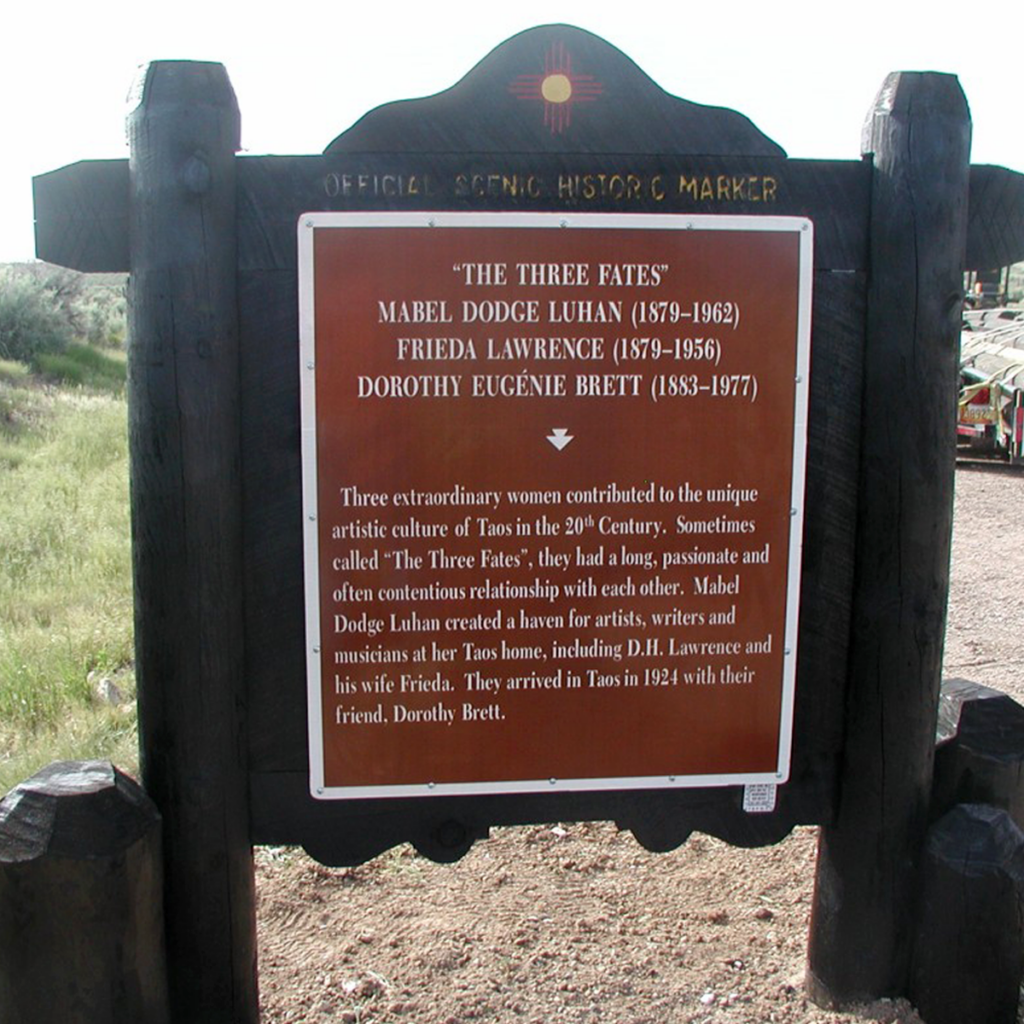The “Three Fates” of Taos.
Three Fates
1879 - 1977
Taos County
Progressive thinkers, intellectuals, and artists, these three women were instrumental in shaping the artistic life of Taos, individually and together. A painting by one of the women entitled “Lawrence’s Three Fates” has become emblematic of their complex relationships with each other and D.H. Lawrence.
Three extraordinary women contributed to the unique artistic culture of Taos in the 20th Century. Sometimes called “The Three Fates,” they had a long, passionate, and often contentious relationship with each other. Mabel Dodge Luhan created a haven for artists, writers, and musicians at her Taos home, including D.H. Lawrence and his wife Frieda, who arrived in Taos in 1924 with their friend, Dorothy Brett. Each of these three women–Luhan, Frieda Lawrence, and Brett–contributed to the vibrant artistic life of Taos in unique and enduring ways.
Frieda Von Richthofen Weekley Lawrence Ravagli (1879-1956)
Emma Maria Frieda Johanna Freiin (Baroness) von Richthofen, was born in Germany. Her father was Baron Friedrich Ernst Emil Ludwig von Richthofen, an engineer in the German army, and her mother was Anna Elise Lydia Marquier.
In 1899, she married a British philologist and professor of modern languages, Ernest Weekley, with whom she had three children, Charles Montague, Elsa Agnès and Barbara Joy. They settled in Nottingham, England, where Ernest taught at the local University. During her marriage with Weekley, she started to translate pieces of German literature, mainly fairy tales, into English and took considerable pride in their publication in book form.
In 1912 she met D. H. Lawrence, at the time a former student of her husband. They fell in love and eloped to Germany, leaving her children behind. During their stay, Lawrence was arrested for spying and, after the intervention of Frieda’s father, the couple walked south, over the Alps to Italy. Following her divorce from Weekley, Frieda and Lawrence married in 1914. They intended to return to Europe, but the outbreak of war kept them in England, where they endured official harassment and censorship. They also struggled with limited resources and D.H. Lawrence’s already frail health.
Leaving post-war England at the earliest opportunity, they traveled widely, eventually settling at the D.H. Lawrence Ranch (the Kiowa Ranch) near Taos, New Mexico, and, in Lawrence’s last years, at the Villa Mirenda, near Scandicci in Tuscany. After her husband’s death in Vence, France, in 1930, she returned to Taos to live with her third husband, Angelo Ravagli.
Mainly through her elder sister Else von Richthofen, Frieda became acquainted with many intellectuals and authors, including the socio economist Alfred Weber, sociologist Max Weber, the radical psychoanalyst Otto Gross (who became her lover), and the writer Fanny von Reventlow.
By approving the dramatization for the theater of D.H.Lawrence’s Lady Chatterley’s Lover–thought to be based partly on her own relationship as an aristocrat with the working class Lawrence–it became his only novel ever to be staged. John Harte’s play was the only dramatization to be accepted by her, and she did her best to get it produced. Although she loved the play when she read it, the copyright to Lawrence’s story had already been acquired by Baron Philippe de Rothschild, who was a close friend. He did not relinquish it until 1960. John Harte’s play was first produced at The Arts Theatre in 1961, five years after Frieda Lawrence’s death on her 77th birthday in Taos.
Mabel Ganson Evans Dodge Sterne Luhan (1879-1962)
In the early 1920’s, a Chicago newspaper reporter described Luhan as “the most peculiar common denominator that society, literature, art, and radical revolutionaries ever found in New York and Europe.” She was indeed a “common denominator” whose life connects social and intellectual issues in late-nineteenth and early twentieth century American and European life. First among these was the issue of the “New Woman” and her relationship to modern America’s emergence from the Victorian age.
Born in Buffalo, New York, she was heiress to a family banking business. Her education was similar to young women of her class: She was schooled in charm and groomed to marry, she felt confined emotionally and intellectually, and she yearned for a life “ennobled by poetry and beauty.” After the accidental death of her first husband, she and her only child were sent to Paris by her family. In 1905, she married Edwin Dodge. They moved to Florence, where she became determined to make a new life that would express her aesthetic impulses. The next eight years began her Renaissance dream. She collected artists and writers for her salon. Gertrude and Leo Stein, Paul and Muriel Draper, Eleanor Duse, Bernard Berenson, and Jacques-Emile Blanche, were guests at her Villa Curonia. She consciously created a life to immortalize herself as a Renaissance lady.
In 1912, she found her Florentine world emotionally and aesthetically bankrupt. She returned to the United States and settled in Greenwich Village, where for the next three years she presided over the most famous salon in American history. Her apartment on Fifth Avenue became internationally known as a gathering spot where the “movers and shakers” of the pre-World War I era engaged in a free exchange of avant-garde ideas in art, politics, and society. On her “Wednesday evenings,” one might find A.A. Brill introducing Freud’s latest theory to a roomful of prominent writers and activists like Walter Lippmann, Max Eastman, and Lincoln Stefens. Margaret Sanger sought support for her birth control movement, Hutchins Hapgood debated the virtues of free love, Bill Haywood and Emma Goldman argued the anarchist’s view of the struggle of the proletariat. Luhan hoped and predicted a brave new world would emerge to replace twentieth century life.
Mabel rejected the Victorian and the fin de siècle world. She and like-minded intellectuals demanded deeper emotional sustenance, a broader social base, and a freer range of expression. They had the optimism and will to experiment that made a new world seem imminent. Within it, men and women would rejoice in their sexuality and all classes would work in harmony for a non-exploitive economic system, while artists, humanists, social scientists, and political activists cooperated to enact change.
Luhan was immersed in the spirit of her times. She supported, wrote, and spoke about various causes that promised to liberate her and her fellow men and women from spiritual and psychological shackles of the past. She was vice president of the Association of Artists and Sculptors that sponsored the Armory Show; a member of the advisory board and contributor to The Masses, the leading left wing journal of the day; a supporter of the Women’s Peace Party; and one of the early proponent of Freudian psychology in a weekly column she wrote for the Hearst papers.
By 1916, the world of revolutionary change she had fostered in Greenwich Village began to feel scattered to her. She feared she would not unite the fragments of her movement. When her third husband, Maurice Sterne, discovered northern New Mexico as an ideal place for her to find herself, she agreed to move. Among the Pueblo Indians of Taos, New Mexico, Luhan discovered a culture that seemed to offer everything she had lacked in her childhood. She had failed to recreate this feeling in Florence and could not find it in Greenwich Village.
Taos was the last place Mabel tried to build what she called a “cosmos.” Here she became a leading proponent of the primitivist doctrines that attracted many alienated white intellectuals in the 1920s. She dreamed of establishing Taos as the birthplace of a new American civilization, one not based on getting and spending or on the redistribution of wealth. Through the 1920s, 1930s, 1940s, she wrote numerous articles both for popular press and for literary journals to convince her fellow Americans that salvation lies in the Indian way. She attracted talented artists, writers, and reformers to Taos. John Marin, Georgia O’Keeffe, and Andrew Dasburg were invited to immortalize the Taos landscape; Leopold Stokowski, to capture the rhythms of native American music; D.H. Lawrence and Robinson Jeffers to help write the gospel of her new found Eden; and John Collier to protect the Pueblos’ lands and cultural identity.
Many more notable personalities frequented Taos leaving a rich legacy in Mabel Dodge Lujan’s name.
Lady Dorothy Eugenie Brett (1883-1977)
Dorothy Brett was the eldest daughter of the 2nd Viscount Esher, Reginald Baliol Brett, and his wife Eleanor van de Weyer, daughter of the Belgian ambassador to the court of St. James. Called “Doll” by her family, she had two older brothers, Oliver and Maurice, and a younger sister, Sylvia. The children were raised in a restrictive environment, similar to other children of the Victorian era. Largely left in the charge of a nanny and other servants, they saw little of their parents. Once the boys were sent to school, a governess was retained for the girls. However, the Brett’s governess was dismissed after a short time and the girls’ education was left to their mother.
The girls lived a fairly secluded life into their early twenties. Aside from dancing classes with the royal children at nearby Windsor Castle, under the supervision of no less than Queen Victoria, their contact with young people their own age was practically nonexistent. One friendship they did make was with Margaret Brooke, Ranee of Sarawak, a friendship disapproved of by the Brett parents. Over ten years Dorothy formed an emotional attachment to the Ranee, and Dorothy’s sister Sylvia attracted the attention of the Ranee’s son, whom she later married against the wishes of her parents. The parents put an end to Dorothy’s visits to the Ranee when she was 23, sending her off to their summer home in Scotland. There, General Sir Ian Hamilton, an old friend of the family, saw some of Dorothy’s drawings and persuaded her parents to send her to the Slade School of Art.
Dorothy Brett was accepted into the Slade School, on a provisional basis, in the fall of 1910. Fellow students at the time included Dora Carrington, Mark Gertler, and David Bomberg. In the tradition of the school, all students dropped their given names and went by their surnames, so Dorothy became Brett to everyone outside her family and went by that name for the rest of her life. Brett completed the four year program at Slade, winning several prizes and honors in her time there.
At the end of her second year, Brett’s father set her up in a studio of her own, partly to help her artistically and partly to move her out of the family home in town where the servants had begun to complain about the “goings on” of Brett’s artistic friends.
Several important events took place in Brett’s life during her school years. She began to develop the auditory problems that would leave her dependent on hearing aids for the rest of her life. She became friends with Gertler and Carrington, and through Gertler she became acquainted with Augustus John, and, in 1914, she met Lady Ottoline Morrell. In October of 1915 Brett met D. H. Lawrence and his wife Frieda.
Over the next several years Brett spent a great deal of time at the Morrell’s Garsington Manor near Oxford along with members of the Bloomsbury group. She seems to have developed a crush on Ottoline which led to voluminous correspondence but little else. In 1919 Brett’s parents helped set her up in a house in Hampstead, London, arranged for an annual allowance, and made a final effort to push her into independence.
In 1923 D. H. and Frieda Lawrence returned to England from North America, thus setting in motion the second phase of Brett’s life. Lawrence had been proposing the creation of a community called “Rananim” (a concept espoused by Lawrence of a Utopia) for several years without success. He felt that he had found the perfect location for such a spot in Taos, New Mexico, and was now actively seeking members. Only John Middleton Murry and Brett seriously considered the idea and in the spring of 1924, only Brett joined the Lawrences on the Aquatania bound for New York.
Taos became Brett’s home. Though she traveled frequently to Mexico and New York and made a few trips back to Europe, her roots were firmly planted in New Mexico. She developed a strong emotional attachment to D. H. Lawrence, and after Lawrence’s death continued to live near Frieda for the remainder of Frieda’s life. Mable Dodge Luhan, another prominent figure in Taos, also played an important role in Brett’s life, alternating between protector and antagonist. Brett’s 1958 painting, “Lawrence’s Three Fates,” memorializes the life they lived together, showing the three women in the Lawrences’ garden under a tree they called “Lawrence’s pine.”
In New Mexico Brett painted Native Americans. She was permitted to visit the Taos Pueblo for important ceremonies and then transferred the images to canvas, creating a series of paintings for which she is perhaps best known, the Ceremonials. Her close relationship to D. H. Lawrence made her popular with the researchers who sought to better understand his life. She died within a few months of her 94th birthday, on August 24th, 1977.
Sources:
Brett, Dorothy. Lawrence and Brett. Introduction, Prologue, and Epilogue by John Manchester. Santa Fe: Sunstone Press, 1974 (Facsimile of 1933 edition; Lippencott, Philadelphia).
Bynner, Witter. Journey with Genius: Recollections and Reflections Concerning the D.H. Lawrences. New York:The John Day Company, 1951.
Byrne Jane. A Genius for Living—A Biography of Frieda Lawrence. London:Bloomsbury Publishing Plc, 1995.
Foster, Joseph. D.H. Lawrence In Taos. Albuquerque:University of New Mexico, Albuquerque, 1972.
Hignett, Sean. Brett: From Bloomsbury to New Mexico, A Biography. London:Hodder & Stoughton, 1984.
Lawrence, Fried. Not I, but the Wind. Santa Fe:Rydal Press, New York:The Viking Press,1934.
Lujan, Mabel Dodge. Lorenzo In Taos: D.H. Lawrence and Mabel Dodge Lujan. New forward by Arthur J. Bachrach, Santa Fe:Sunstone Press, 2007 (Facsimile of 1932 edition, Alfred A. Knopf).
Lujan, Mabel Dodge. Movers and Shakers, Volume 3 of Intimate Memories. New York:Harcourt, Brace & Company, 1936.
Pettey, Chris. An International Dictionary of Women Artists born before 1900, Boston:G.K. Hall, 1985.
Rudnick, Lois Palken and Mabel Dodge Lujan: New Woman, New Worlds. Albuquerque:University of New Mexico Press, 1987.
Sergeant Shepley Elizabeth. Personal Papers, Special Collections Department, Bryn Mawr College Library. Collection Number 10.
Tedlock, E.W., ed. Frieda Lawrence: The Memoirs and Correspondence. Alfred A. Knopf (1964).
http://beinecke.library.yale.edu/awia, downloaded March 9, 2010 on an exhibition at the Beinecke Rare Book and Manuscript Library, Yale University, July 28-October 18, 2003, New Haven, CT. Intimate Circles; American Women in the Arts. Essay on the Southwest, “That Strangest of American Places.”
Directions:
Three Fates
Taos County
Activist | Artist | Community leader |
Statehood (1912 - present) | Territorial Period (1848 - 1912) |
North Central



